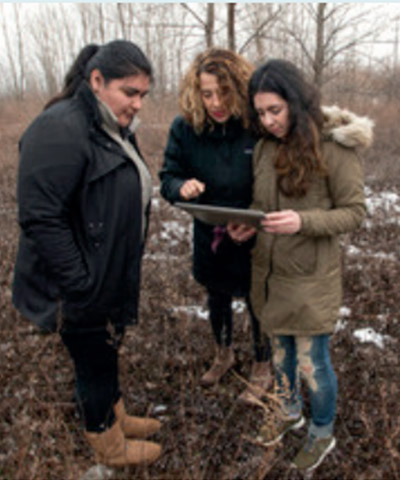Turning Brownfields into “Greenfields”

UIC SPH students and community members repurpose vacant lots as solar farms on Chicago's South Side
Repurposing formerly unproductive land for renewable energy provides surrounding communities with a sustainable, clean energy source, and creates new opportunities in low-income, urban areas. Undergraduate public health students have been working with Bruce Montgomery, the Director of the Urban Innovation Center, to find suitable sites for solar farms in Englewood and Bronzeville. Many of the vacant lots in the community are former industrial sites, or brownfields, and potentially contaminated with toxic chemicals or waste.
test Heading link

“There are large amounts of land that are underutilized in urban communities, especially in Englewood. It’s very difficult to bring those properties back to productive use because before anyone can do it, they’ve got to clean up what was there before,” Mr. Montgomery said.
Mr. Montgomery is working with the community to create micro-grid solar farms. Community members could also be trained in maintaining and operating the panels, he said. And on sunny days when the panels generate excess energy, it can flow back to the grid, reverse the meter, and create new sources of income for the community, he said.
“These communities are low-income, so they wouldn’t just have a few thousand dollars to just go off and put solar up on their roof. The idea is that you could identify one of these brownfields and populate it with solar,” he said. “The solar energy can be produced and shared in the surrounding homes, and in the first time in forever, these residents would be something other than a rate payer, they could be an energy producer.”
UIC SPH students are involved with the project as part of “Public Health 360: Local Citizenship and Community Health Initiatives,” taught by Dr. Laurel Berman (PhD ‘06, MS ‘02), adjunct assistant professor, and Dr. Serap Erdal, associate professor of environmental and occupational health sciences at UIC SPH. The community-focused course gets the students out in the community where they can apply what they’ve learned in the classroom.
“We’ve been working on community engagement and learning how to partner with organizations in order to address a specific public health issue. We’ve been doing research on brownfield sites and learning how to gain community trust,” said student Evelyn Velazquez. Ms. Velazquez and her group, Melissa León, Feliciano Ocegueda, and Jamie Danemayer, have been working with the Urban Innovation Center to map the area’s vacant lots and determine what clean-up might be needed before the sites can be used for solar farms. Later in the semester, the group will introduce their findings and explain the benefits of urban solar farms and other energy innovation projects at a community meeting.
text2 Heading link

Students learn the history of the vacant sites by speaking with community members and nonprofits, and researching local and state databases, Dr. Berman said. The site history gives them an idea of what clean-up is needed before the site can be safely used for other purposes.
“With properties like this, sometimes there’s no contamination. I think an estimate would be about 30 percent are not contaminated. So, brownfields are an opportunity for redevelopment,” Dr. Berman said.
The urban solar project is just in the initial stages, but with community buy-in, an agreement with the local energy provider, and sufficient funding, it could become a reality.
In addition to the urban solar project, Drs. Berman and Erdal are managing twelve other student projects focused on UIC SPH students and community members repurpose vacant lots as solar farms on Chicago’s South Side community health, social, and environmental issues. Many are in communities on Chicago’s South Side.
One student group is working with Cheryl Johnson’s organization, People for Community Recovery (PCR), to convert a former gas station in Riverdale into a museum honoring the environmental justice movement. Ms. Johnson’s mother Hazel, the founder of PCR, was an early leader in the environmental justice movement.
“Cheryl Johnson is following in her mother’s footsteps. Our students are helping her turn projects into reality. The work also has a larger significance, because People for Community Recovery has prominence nationally [in the history of environmental justice],” Dr. Erdal said.
Some of the projects focus on turning vacant land into healthy, usable space or housing, and others are working with those experiencing homelessness. One group has partnered with the Southeast Environmental Task Force on the City’s Southeast side to establish a database tracking the activities surrounding petcoke, a potentially toxic byproduct of the petroleum refining process. All of the projects engage students with the health and environmental issues affecting their local communities.
“We tell them from day one that they will be working with communities, applying what they are learning in the class in the field. The students know that this is just a first stab—it takes years to build relationships in communities, but we are getting them to think about it early,” Dr. Berman said.